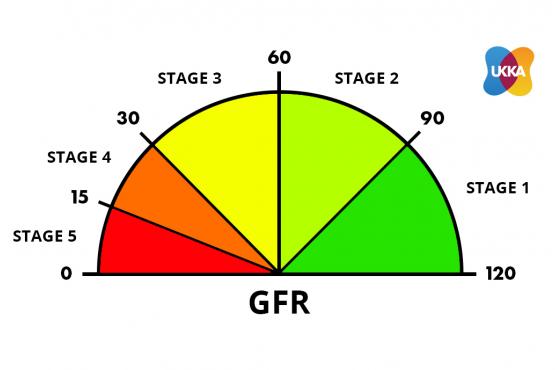Chronic kidney disease (CKD): a summary and FAQs
In this article we describe 10 frequently asked questions (FAQs) about chronic kidney disease (CKD).
Keep track of your kidney data with PKB
1. Where are the kidneys located?
They are near the middle of your lower back, on either side of spine.

This diagram shows the location of the kidneys. The right kidney is slightly lower (and smaller), and is pushed down by the liver.
2. What do the kidneys do? (7 functions)
The kidneys primary role is to be the body’s dustmen. But, in fact, this is only one of their 7 functions.
The kidney has 3 excretory functions – i.e. removes things:
Waste removal (dustmen role)
Excess water removal
Acid removal.
And 4 metabolic functions – i.e. or makes or activates (strengthens) substances:
Blood pressure control (makes renin)
Anaemia, red blood cells and erythropoietin (EPO) (makes EPO)
Vitamin D activation (activates cholecalciferol)
Make prostaglandins.
3. What is CKD (chronic kidney disease)?
The phrase CKD means either:
- a long-term reduction in kidney function OR
- an abnormal kidney structure (with normal function).
A mild form is very common – affecting up to 10% of the population.
For many of these, CKD is really a risk factor for a more serious problem later in life. This can be addressed which is why only 1 in 100 people end up requiring dialysis or a kidney transplant
4. How is CKD diagnosed?
This is done using the 5 stage CKD/eGFR classification. Normal human GFR is 90-120 ml/min.

Courtesy of UKKA
CKD1+2 – risk factors for CKD (eGFR 60-120 ml/min)
CKD3A – mild CKD (eGFR 45-59 ml/min)
CKD3B – mild-moderate CKD (eGFR 30-44 ml/min)
CKD4 – moderate CKD (eGFR 15-29 ml/min)
CKD5 – severe CKD (kidney failure) (eGFR < 15 ml/min)
– CKD1 means you can have an abnormal kidney structure with normal kidney function
– CKD4 means you may require dialysis or a kidney transplant one day
– CKD5 means you will require dialysis, or a kidney transplant, or supportive care (no dialysis).
5. What are the 7 causes of CKD?
There are 7 groups of causes:
- Unknown (often with small kidneys). This is the ‘cause’ in 30% of patients
- Diabetes (mainly type 2). This is the cause in 20% of patients, i.e. the second commonest
- Renovascular (kidney artery) disease (RVD)
- Obstructive nephropathy. This means a blockage in the drainage system of the kidneys – i.e. ureters, bladder, or prostate (in men)
- Glomerulonephritis (GN) / vasculitis. These are ‘autoimmune’ diseases (and there are 7 types). This means the body’s immune system (normally its defender) attacks the small blood vessels within the kidneys
- Tubulointerstitial disease (TID). This is not really just one diagnosis. The phrase refers to a group of kidney conditions that mostly affect the tubules
- Polycystic kidney disease (PKD). This is the only common familial (inherited) cause.
6. What are the symptoms of CKD?
CKD is largely asymptomatic until CKD stages 4 or 5. Shortness of breath and ankle swelling are red flag symptoms, and occur at these later stages.
There is more information here.
7. What treatment can a doctor offer someone with CKD?
Even though CKD is not normally curable, there is alot doctors and the NHS can do. Does everyone with CKD need treatment? No.
There is more information here.
8. What can I do to help myself?
There are the THREE important things you can do to help yourself:
1. Monitor (and write down) the 2-3 numbers written below. The blood and urine tests can be performed and monitored by your GP, but you can do a lot of this yourself; to help GP and nephrologist (hospital kidney specialist) if you have one.
- Creatinine blood test. This is the most reliable measure of kidney function; the higher the number the worse the kidney function. It should be below 120 mcmol/L, and be measured every 3-6 months – more frequently if CKD worsens
- eGFR. The creatinine level determines your eGFR and hence CKD stage – the higher the creatinine, and lower eGFR, the higher (i.e. worse) CKD stage [“yes it is confusing” Ed]. eGFR should be above 60 mls/min, ideally above 90 mls/min. It should be also measured every 3-6 months
Note. You can chase your own blood tests using the Patient Knows Best (PKB) website - Urine protein in the urine. Some patients need urine protein measurements too, this is calculated with a simple urine test. When the kidneys leak protein it is a sign of strain. It is called a ‘uACR’ (urinary albumin-to-creatinine ratio). Again, you should chase the protein level – again via Patient Knows Best.
2. Blood pressure – make this a primary focus. Having normal or low blood pressure is the most useful thing you can do for CKD. So, buy a BP machine from any chemist or large supermarket or Amazon – prices vary, approximately £20-£40. ‘A&D’ is a good make. Take your own BP once a week until stable.

Get your BP checked. Better still buy your own machine and check it yourself.
3. Know your medication. Many people with CKD take alot of medication: to lower blood pressure (especially two types of blood pressure medicine, ACE inhibitors and ARBs); remove fluid (diuretic, i.e. water tablet), control blood glucose, and lower cholesterol. In more advanced CKD they may take vitamin D, a phosphate binder and erythropoietin (EPO). It is important to understand your medications, and take them as prescribed. Do not run out.
There is more information here about other things you can do to help yourself.
9. How often do I need my eGFR/creatinine measured?
This is very variable. It can be anything from once a week to once a year.
There is more information here.
10. What is the outlook for CKD?
It is generally good, but (again), very variable. The majority of people have CKD1-3 and do not progress to CKD4-5.
There is more information here.
Summary
We have described chronic kidney disease (CKD): a summary and FAQs. We hope it has been helpful.
Other resources
10 IHD facts
10 CHF facts
10 diabetes facts
10 cholesterol facts
Last Reviewed on 22 June 2024
